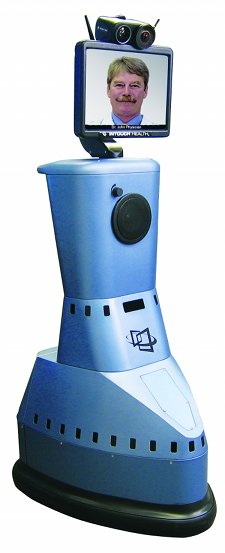 Grande Ronde Hospital in La Grande is a rural, 25-bed facility with no cardiologist on staff. Two years ago, a heart patient there would have had to drive three hours to Boise. But now patients can get instant, face-to-face appointments with a cardiologist without anyone driving anywhere.
Grande Ronde Hospital in La Grande is a rural, 25-bed facility with no cardiologist on staff. Two years ago, a heart patient there would have had to drive three hours to Boise. But now patients can get instant, face-to-face appointments with a cardiologist without anyone driving anywhere.
Photo of the R-7 courtesy of InTouch Technologies |
LA GRANDE Grande Ronde Hospital in La Grande is a rural, 25-bed facility with no cardiologist on staff. Two years ago, a heart patient there would have had to drive three hours to Boise. But now patients can get instant, face-to-face appointments with a cardiologist without anyone driving anywhere.
Well, that’s not entirely true. The cardiologist has to drive EDGAR (“Educated Doctor-Guided Assisting Robot”) from its parking spot in the hallway to the patient’s room.
EDGAR is the keystone of Grande Ronde’s telemedicine program, which recently won the Outstanding Rural Health Organization of 2009 award from the National Rural Health Association. The robot allows specialists to consult remotely, saving patients the time and money of traveling to a larger hospital. Because of EDGAR, tiny Grande Ronde, which sees only 15 or 16 patients a day, has 16 staff members with special ICU training who beam in from St. Louis, Mo. Recently, the hospital hosted a distance-learning class on stroke care, avoiding travel costs for 30 nurses. The hospital plans to add remote dermatologists, a 24-hour pharmacy, and three-way consultation capability.
Meaghan McCamman, an NRHA manager, says rural hospitals face challenges such as recruiting and retaining qualified health-care workers. Their low patient volume and higher poverty populations also mean they have a much lower margin than urban hospitals.
Telemedicine addresses those issues, says Doug Romer, executive director of patient care services at Grande Ronde. Telemedicine attracts young health-care workers because it exposes them to expertise not usually found in rural hospitals, and it allows the hospital to recoup some costs by keeping patients on the ward.
The $45,000 wireless network necessary to make EDGAR work was paid for by St. Alphonsus Regional Medical Center in Boise. St. Alphonsus is the hub for remotely connected doctors and nurses at rural hospitals in Oregon and Idaho.
That money was a federal grant, so next year Grande Ronde will have to take on the approximately $4,500 it takes to run the program each month. But there’s no debate about whether to keep EDGAR, Romer says.
“Our board of trustees has recognized that technology is the future,” he says. “If we can provide the care without having to travel, that’s what we want to do.”



